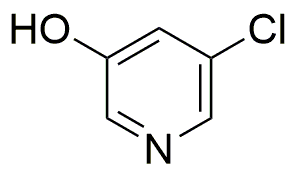3-Chloro-5-hydroxypyridine is widely utilized in research focused on:
- Pharmaceutical Development: This compound serves as a key intermediate in the synthesis of various pharmaceuticals, particularly those targeting neurological disorders. Its unique structure allows for modifications that enhance drug efficacy.
- Agricultural Chemicals: It is used in the formulation of herbicides and fungicides, providing effective solutions for pest control. The compound's ability to disrupt specific biological pathways makes it valuable in crop protection.
- Analytical Chemistry: Researchers employ this chemical as a reagent in various analytical techniques, including chromatography and spectroscopy, to detect and quantify other compounds in complex mixtures.
- Material Science: It is utilized in the development of new materials, such as polymers and coatings, where its properties contribute to enhanced durability and resistance to environmental factors.
- Biochemical Research: The compound is important in studying enzyme interactions and metabolic pathways, helping scientists understand biological processes and develop new therapeutic strategies.
Informations générales
Propriétés
Sécurité et réglementation
Applications
3-Chloro-5-hydroxypyridine is widely utilized in research focused on:
- Pharmaceutical Development: This compound serves as a key intermediate in the synthesis of various pharmaceuticals, particularly those targeting neurological disorders. Its unique structure allows for modifications that enhance drug efficacy.
- Agricultural Chemicals: It is used in the formulation of herbicides and fungicides, providing effective solutions for pest control. The compound's ability to disrupt specific biological pathways makes it valuable in crop protection.
- Analytical Chemistry: Researchers employ this chemical as a reagent in various analytical techniques, including chromatography and spectroscopy, to detect and quantify other compounds in complex mixtures.
- Material Science: It is utilized in the development of new materials, such as polymers and coatings, where its properties contribute to enhanced durability and resistance to environmental factors.
- Biochemical Research: The compound is important in studying enzyme interactions and metabolic pathways, helping scientists understand biological processes and develop new therapeutic strategies.
Documents
Fiches de données de sécurité (FDS)
La FDS fournit des informations de sécurité complètes sur la manipulation, le stockage et l’élimination du produit.
Spécifications du produit (PS)
Le PS fournit une description complète des propriétés du produit, notamment sa composition chimique, son état physique, sa pureté et les exigences de stockage. Il détaille également les plages de qualité acceptables et les applications prévues du produit.
Certificats d'analyse (COA)
Recherchez des certificats d'analyse (COA) en saisissant le numéro de lot du produit. Les numéros de lot et de lot se trouvent sur l'étiquette d'un produit, après les mots « Lot » ou « Lot de fabrication ».
Numéro de catalogue
Numéro de lot/série
Certificats d'origine (COO)
Ce certificat d'exploitation confirme le pays dans lequel le produit a été fabriqué, et détaille également les matériaux et composants utilisés et s'il est issu de sources naturelles, synthétiques ou autres sources spécifiques. Ce certificat peut être requis pour les douanes, le commerce et la conformité réglementaire.
Numéro de catalogue
Numéro de lot/série
Fiches de données de sécurité (FDS)
La FDS fournit des informations de sécurité complètes sur la manipulation, le stockage et l’élimination du produit.
DownloadSpécifications du produit (PS)
Le PS fournit une description complète des propriétés du produit, notamment sa composition chimique, son état physique, sa pureté et les exigences de stockage. Il détaille également les plages de qualité acceptables et les applications prévues du produit.
DownloadCertificats d'analyse (COA)
Recherchez des certificats d'analyse (COA) en saisissant le numéro de lot du produit. Les numéros de lot et de lot se trouvent sur l'étiquette d'un produit, après les mots « Lot » ou « Lot de fabrication ».
Numéro de catalogue
Numéro de lot/série
Certificats d'origine (COO)
Ce certificat d'exploitation confirme le pays dans lequel le produit a été fabriqué, et détaille également les matériaux et composants utilisés et s'il est issu de sources naturelles, synthétiques ou autres sources spécifiques. Ce certificat peut être requis pour les douanes, le commerce et la conformité réglementaire.


